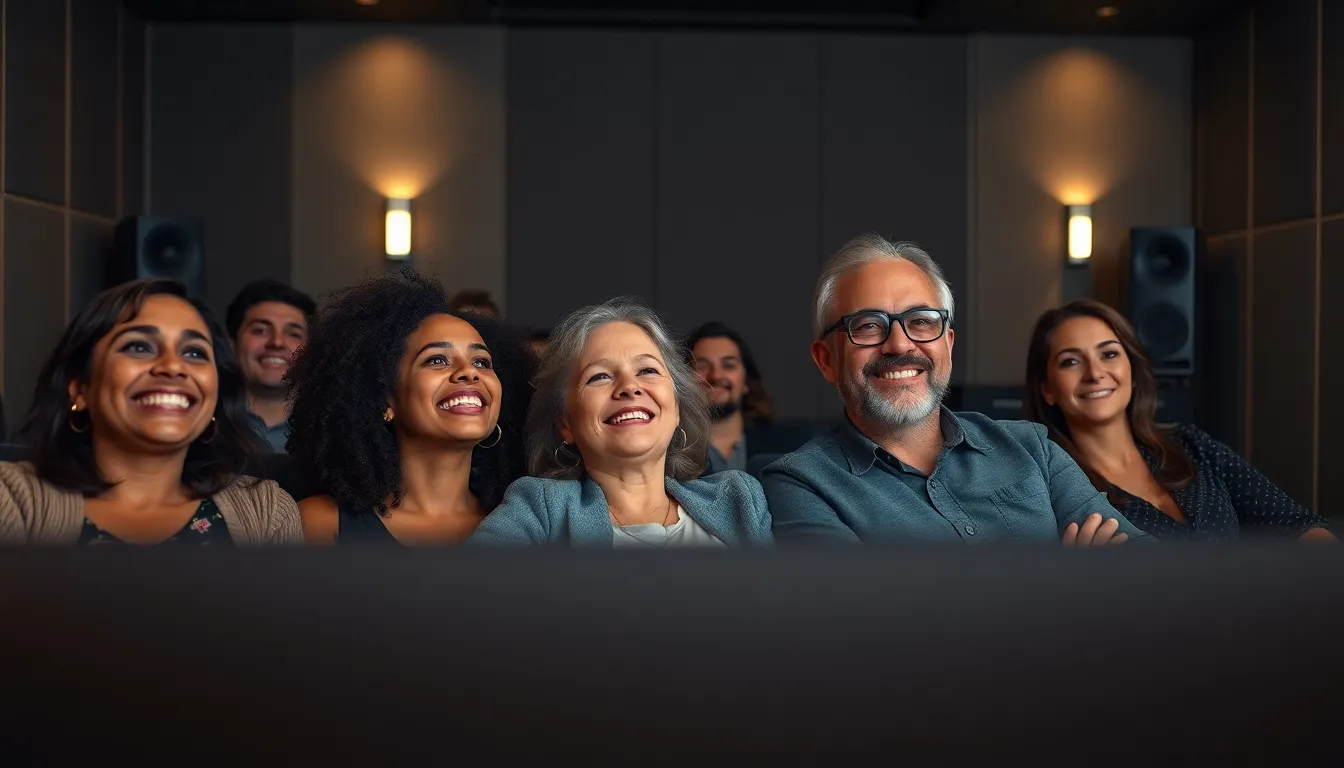Imagine a world where sound wraps around you like a warm blanket, making you feel like you’re right in the middle of the action. That’s the magic of object-based audio. Gone are the days of flat, lifeless sound that only comes from two speakers. Instead, this innovative technology places individual sounds as distinct objects in a three-dimensional space, creating an auditory experience that’s as immersive as a blockbuster movie.
Whether it’s the rustling of leaves behind you or the distant roar of a train approaching, object-based audio makes you feel like you’re living the scene. It’s not just for audiophiles; it’s for anyone who wants to elevate their listening experience to a whole new level. So grab your headphones, sit back, and get ready to discover how this cutting-edge technology is redefining the way we hear the world around us.
Table of Contents
ToggleOverview of Object-Based Audio
Object-based audio revolutionizes sound reproduction by enabling individual sound elements to exist as separate entities in a three-dimensional space. This technology enhances audio experiences, moving beyond traditional formats to deliver immersive soundscapes. Listeners can perceive sounds in a manner reminiscent of real life, such as hearing footsteps approaching from behind or experiencing ambient noises surrounding them.
With the use of metadata, sound designers can strategically place each sound where it belongs, creating a dynamic and engaging experience. This capability allows for sophisticated mixing, where sounds can shift relative to the listener’s position. The result is an audio environment that adapts to movements, making it feel as if the sound reacts to the listener’s actions.
Additionally, object-based audio supports various formats, including Dolby Atmos and MPEG-H, which are utilized in cinema and home entertainment. These formats optimize sound playback across different devices, ensuring quality remains consistent whether in a theater or on headphones.
Accessibility also plays a vital role in the growth of object-based audio. It’s designed for both casual listeners and professionals, making it easier for anyone to engage with premium audio. Various applications, such as gaming, music, and virtual reality, benefit significantly from this technology, amplifying engagement and interaction.
Object-based audio transforms listening experiences, inviting everyone to explore sound in rich detail.
Key Technologies Behind Object-Based Audio

Object-based audio relies on advanced technologies to enhance how sound interacts with listeners. This section explores crucial technologies like spatial audio and immersive sound systems that elevate the audio experience.
Spatial Audio
Spatial audio enables precise positioning of sound within a three-dimensional space. By utilizing algorithms, this technology simulates how humans naturally perceive sound direction and distance. Various formats, such as Dolby Atmos and MPEG-H, allow sound designers to scatter audio elements dynamically. Listeners experience sound moving around them, creating an engaging atmosphere. It adapts to different devices, ensuring consistent quality from speakers to headphones. This flexibility enhances applications across gaming, film, and music. Moreover, it fosters a more natural connection to the auditory environment, effectively immersing individuals in the content.
Immersive Sound Systems
Immersive sound systems create multidimensional soundscapes that envelop the audience. These systems integrate various audio sources, providing a seamless blend of sounds from multiple directions. The implementation of object-based audio allows each sound to exist independently, adjusting according to the listener’s movements. Reports indicate that immersive systems substantially increase user engagement in entertainment settings. Popular examples include cinema installations that utilize overhead speakers for a three-dimensional experience. Such systems also thrive in home theater setups, enhancing the movie-watching experience. Applications extend into virtual reality, where accurately positioned sound adds realism. Ultimately, immersive sound systems redefine how audiences interact with audio.
Benefits of Object-Based Audio
Object-based audio transforms the listening experience by offering numerous benefits. Listeners enjoy a heightened sense of immersion and engagement, feeling enveloped in dynamic soundscapes.
Enhanced User Experience
Enhanced user experience stems from the ability of object-based audio to create realistic sound environments. Factors like the precise placement of sounds enhance the listener’s sensation of being part of the scene. Surroundings feel richer and more textured, allowing individuals to perceive audio in a three-dimensional space. In entertainment settings, this leads to greater emotional involvement with the content. Gamers also benefit from this technology, which contributes to a more captivating gameplay experience. As sound elements move, they respond to the listener’s actions, making interactions feel more authentic.
Flexibility and Adaptability
Flexibility and adaptability characterize object-based audio systems, allowing them to function across diverse platforms. Compatibility with a range of formats, including Dolby Atmos and MPEG-H, ensures sound quality remains consistent on different devices. Non-traditional setups can deliver high-quality audio in any environment, from home theaters to headphones. Sound designers can tailor audio experiences for specific audiences, adjusting elements based on user preferences. By integrating metadata, systems adapt in real-time to enhance overall engagement. This responsiveness is critical in applications like virtual reality, where realistic soundscapes significantly elevate immersion.
Applications of Object-Based Audio
Object-based audio finds applications across various fields, enhancing the listening experience significantly. This technology transforms how audiences engage with sound in film, television, gaming, and more.
Film and Television
In film and television, object-based audio elevates storytelling through immersive soundscapes. Sound designers position specific audio elements, such as dialogue or effects, within a three-dimensional space, creating an engaging environment. Audiences experience realistic sound movements that follow the action on screen. The integration of Dolby Atmos in cinemas and home viewing platforms ensures consistency across devices, enhancing emotional resonance. Studios utilize object-based audio to transform scenes, making every rustle, whisper, and explosion feel immediate and alive.
Gaming
Gaming incorporates object-based audio to heighten player immersion and interaction. Sounds appear to come from different directions, allowing gamers to locate enemies and anticipate actions accurately. The dynamic placement of sound enhances gameplay by responding to player movements, providing a multi-layered auditory experience. Many popular games now leverage this technology to deliver an engaging atmosphere through enriched spatial audio. Players find themselves more deeply connected to the game world, as sound effects become an integral part of the overall gaming experience.
Challenges and Considerations
Object-based audio offers innovative sound experiences but comes with challenges that must be addressed for optimal utilization.
Technical Limitations
Technical limitations can hinder the full implementation of object-based audio. Limited bandwidth may restrict high-quality audio streaming, affecting listener experiences. Some legacy audio equipment doesn’t support advanced formats like Dolby Atmos, leading to discrepancies in playback quality. Objects can sometimes exceed rendering capabilities of devices, resulting in inconsistent sound reproduction. Additionally, mastering audio for multiple formats requires extra effort, as not all platforms handle object-based audio seamlessly. These limitations highlight the importance of ongoing advancements in technology.
Industry Adoption
Industry adoption poses a significant challenge for widespread implementation. Many audio engineers and content creators may lack familiarity with object-based audio, which slows integration into workflows. Training and resources for professionals in various sectors, including film and gaming, remain limited. Some distribution platforms prioritize traditional audio formats, delaying the transition to innovative sound technologies. While major studios and developers embrace these advancements, smaller entities may hesitate due to costs or resource constraints. A gradual acceptance within the industry is essential for unlocking the full potential of object-based audio.
Object-based audio is reshaping how listeners experience sound. By immersing them in a three-dimensional audio landscape, it enhances emotional engagement and interaction across various media. The technology’s flexibility caters to both casual listeners and professionals, making it an exciting development in the audio world.
Despite some technical challenges and industry adoption hurdles, the potential of object-based audio is vast. As advancements continue and familiarity grows, it’s likely to become a standard in audio production. Embracing this innovative approach can lead to richer and more captivating sound experiences, inviting everyone to explore the new dimensions of audio.




